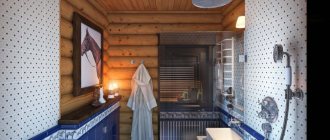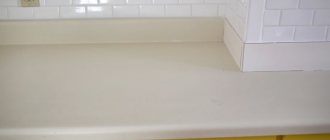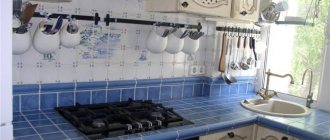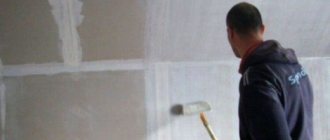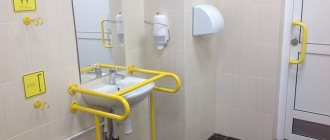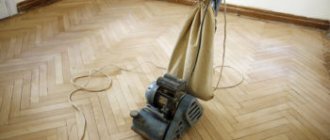What bath is complete without a sink? Perhaps, such things do not happen, well, unless the dimensions of the room are reduced and only a bathtub is installed in it. And in other cases, no home can do without a washbasin. Their choice is approached with all responsibility. Recently, more and more often you can see in the bathroom a sink built into the countertop, which does not take up much space and serves as a dressing table.
Its surfaces can be used for personal purposes, and you can put a washing machine under the sink, which is very convenient. Thanks to the right countertop, you can significantly save space in the bathroom, and if you can’t find an option with suitable dimensions, then craftsmen make it themselves to fit any dimensions.
How to attach a bathroom countertop to a wall?
Share on social media networks:
- Requirements
- Correct selection of materials
- How to install a countertop in a bathroom under a sink?
- Video material
A countertop in a bathroom is one of the convenient design solutions. It's not just beautiful, but convenient and practical. At the same time, installing the countertop is not so difficult. You can do this yourself. Let's try to figure this out. So, the topic of the article is how to attach a bathroom countertop to a wall. First of all, it is necessary to take into account the characteristics of the room, because the bathroom, as a rule, has modest dimensions. At the same time, free access to engineering structures in the future is necessary. Everything will be discussed in more detail below.
Other materials for manufacturing
It is more difficult to create a cozy atmosphere in the bathroom due to the functional features of the room. High humidity, lack of windows, need to install forced ventilation. With all these signs, choosing a material for the bathroom becomes difficult.
Even in emergency cases, a glass product is practically safe for humans
Manufacturers suggest considering other materials for countertops:
- glass is one of the fashionable materials of the season. Modern polymers for glass are resistant to scratches and synthetic detergents, and are shock-resistant. Transparent and colored tabletops are available.
- Chipboard and MDF are polymer materials based on wood waste. For the bathroom, laminated slabs are used; the pattern and color are chosen individually.
- stone, natural (marble) or artificial, is used in the interior more often than others, since it has excellent moisture resistance and can be processed. Artificial stone imitates natural stone and is also available in designer patterns and colors.
- Gypsum plaster is a building material that is easily shaped. A structure of non-standard configuration is made from this material. Disadvantages include instability to moisture. This can be avoided if the product is coated with moisture-resistant paint or tiled. To install such a structure under a washbasin, first assemble a frame from wooden blocks or a metal profile.
- steel is a stainless metal alloy that is found in modern interiors. Durability and decorative capabilities allow you to create laconic designer household items. The metal surface can be polished, glossy or matte, and is generally resistant to scratches and maintenance products;
- ceramics, allows you to install a structure that imitates the texture of wood, glass mosaic, and other decorative methods for the bathroom interior;
A wide selection of mosaic tiles will help decorate a bathroom in Italian or Oriental styles and give the countertop strength
Mounting methods
A kitchen countertop or hanging dining table can be mounted against the wall in different ways, which also imply different loads.
Fixing a table with or without support using angle brackets
This is the most common and reliable method of fixing surfaces experiencing different loads. This method uses a special device - a bracket, which is a metal corner. Creates sufficient reliability and strength of the connection. It is fixed to the wall part and the table using bolts.
The part must have a right angle. This corner fits snugly into the corner space between the table surface and the wall. It may have additional reinforcing elements that make the structure even more reliable and allow the surface to be fixed even without supports and legs.
To ensure high-quality fastening, the bracket itself must be sufficiently reliable. Therefore, when purchasing, pay attention to each detail separately. The brackets must be intact and in good working order, they must not have mechanical damage.
Step by step instructions for installation below using the corner below.
- Determining the location of fixation. It is necessary to decide not only on the location of the surface, but also on the location of the fastening elements. They should be evenly located along the entire lower part of the table, evenly absorb the load, and not interfere with the use of furniture. The longer the surface, the more fastening elements will be needed. This is necessary to compensate for the bending moment that acts on the horizontal plane.
- Marking locations for the location of fastening elements. Apply the necessary serifs with a pencil. These are the mounting locations. Such notches will not only make your work easier in the future, but will also help you install the parts correctly and evenly.
- Place fastening elements. If this is a corner type of fastener, then you need to attach the part to the wall part and make a few more notches for future nests. These sockets are the places where the bracket will be secured to the wall using bolts.
- Place a horizontal surface on the fastening elements.
- Check the reliability and quality of the work performed. Try to lean on the surface or shake it with little effort. If it is fastened securely enough, it should stay in place. If the fastening is poor, it will regain mobility.
Watch the visual instructions in the video:
Fastening the kitchen countertop to timber
This fixation option ensures immobility and provides additional stability when the countertop sag due to a mismatch between its depth and the width of the lower cabinets, if heavy kitchen appliances are supposed to be stored in the work area against the wall.
To attach the timber, markings are made on the wall along the top edge of the tabletop. From this line downwards its thickness is laid down - this is the lower edge and the upper boundary for mounting the timber on which it will subsequently be laid.
After selecting the thickness of the timber and also marking it on the wall, the places for the dowels are drilled.
Holes are also drilled in the timber. They fasten it to the wall with anchor bolts, after which the tabletop is laid on a beam attached to the wall.
Wood selection
The main criterion that is taken into account when choosing a finished product or material for its manufacture is the type of wood. Operating conditions in the bathroom require the use of high-density wood, which, in conditions of high nesting, does not rot or deform.
Merbau - texture
The degree of moisture resistance varies for different breeds.
A high degree of resistance is characteristic of oak, larch and teak. have an average degree of resistance .
The listed breeds are characterized not only by built-in strength and moisture resistance, but also by a rich color range with an expressive natural pattern. This wood is not afraid of temperature changes and mechanical stress due to its high density.
The low resistance of maple, aspen, birch, beech and linden is not recommended for use in the bathroom. Even special treatment cannot save the wood of these species from the harmful effects of moisture.
When choosing a material for making countertops yourself, take into account the processing of wood - it must be well dried and evenly treated with protective compounds.
Oak
When purchasing a finished product, you should be guided by the style of the room and its color scheme. On sale you can find both products with regular geometric shapes and models with uneven, raw edges with a deliberately rough appearance. There are products with an artificially aged surface using brushing or firing techniques. All these characteristics affect only the appearance of the countertops, but not their performance properties.
Alder
Countertops go on sale in a completely ready-to-use form, having initially undergone all stages of protective treatment: impregnation with protective compounds and varnishing. Therefore, the new product does not require additional processing. But after a while, protective equipment will be needed in order to extend the life of the countertop and maintain its visual appeal.
Mounting options
There are several options for how to install a countertop in a bathroom, and each of them depends on your personal preferences. Today there are three main types of installation:
- wall mounting using brackets;
- installation on furniture elements in the form of cabinets with doors or pull-out cabinets;
- mounting on legs, in this case the tabletop can have one leg at each corner or only two legs at the outer corners, and its inner part is fixed to the wall.
Important. If the bathroom is lined with plasterboard and ceramic tiles, then before installing the countertop in the bathroom on the wall, it is necessary to pre-determine its installation location at the stage of installing the plasterboard and additionally reinforce the mounting location with metal profiles or wooden beams. Drywall itself is a fragile material and will not support the weight of the countertop.
Mounting the tabletop to the wall
If you decide to mount the product on the wall, leaving the space underneath it free, then in this case, use a special bracket for the bathroom countertop. This bracket is L-shaped and has special stiffening ribs that prevent bending. It also has pre-drilled holes for wall mounting. The installation process is as simple as possible: the brackets are securely fixed to the wall using dowels, then the tabletop is laid on them and secured with screws.
Important. It is advisable to select the brackets in such a way that the side on which the tabletop will lie is no more than half the width of the tabletop itself. Also pay special attention to the material of the bracket and the presence of stiffeners.
Installation on furniture elements
Installing a bathroom countertop on furniture pieces is the most common installation option, especially in small rooms. This allows you to use the space under the countertop to store bath accessories. As a base, choose one or several cabinets of the same height, depending on the size of the tabletop. Before fixing the countertop in the bathroom in this way, the cabinets are connected to each other with bolts, and the countertop itself is installed on them and fixed to the cabinets with metal corners.
For your information. The presence of cabinets allows you to hide the wiring elements and siphon if a washbasin is installed on the countertop. The gap between the tabletop and the wall is closed with a plastic decorative corner, which is glued with sealant. It is important to leave a small distance of a few centimeters between the cabinets and the wall for ventilation.
Foot mounting
Attaching a bathroom countertop to legs is usually used in spacious rooms where saving space and rational use of it is not a priority. This option will also be appropriate if the tabletop itself is too heavy and brackets alone will not be enough. Everything is as simple as possible here. One side of the product is attached to the wall on brackets, and the outer side is mounted on decorative legs.
Pros and cons of wooden countertops
Conditions for wood in a bathroom are more favorable than in a bathhouse or sauna, but it is not a traditional material - preference is usually given to surfaces made of ceramic, stone, plastic or stainless steel, as they are highly resistant to moisture.
Country style
Before making a choice in favor of a wooden countertop, it is recommended to weigh the pros and cons.
Slabs coated with epoxy resin look especially impressive.
The advantages of natural wood and products made from it include the following:
- Proper operation and care guarantee a long service life of the product - from 20 to 30 years.
- Wood texture is aesthetically pleasing and works well in many styles and in combination with most finishing materials.
- Warm wood tones make the bathroom interior warm and comfortable.
- Tabletops made of solid wood or slabs are always an exclusive, one-of-a-kind piece of furniture with an original, unique pattern and shade.
Wood slabs - Wood is an environmentally friendly, safe material. It does not cause allergies. In addition, wood releases a subtle aroma and natural phytoncides into the environment, which have a beneficial effect on the indoor microclimate.
- Wood is a soft and pliable material that can be given any shape by manual or mechanical processing.
- The wooden surface is pleasant to the touch, unlike stone or metal.
- Over time, the tabletop may lose its original luster, but it can be easily restored.
- The low weight of a wooden tabletop facilitates the process of its manufacture and installation.
- If desired, you can make a tabletop yourself or choose the desired model from a wide range.
Wooden stand with chest of drawers function
The disadvantages include the following:
- Any type of wood is susceptible to moisture to one degree or another. As a result of improper protection, use and care of a wooden tabletop, it will begin to rot and deform, lose its load-bearing capacity, and eventually collapse completely.
- Wood is afraid of temperature changes, which lead to its deformation. The influence of hot, humid air negatively affects the geometry of the product, which shrinks and cracks over time.
- The soft and pliable material is easy to damage and leave a scratch or dent on its surface.
- The hydrophobicity of wood means that it easily absorbs any liquid.
- High price.
From the above it follows that the key to long-term operation of the product is careful operation and special care.
Decorating a bathroom in eco style
DIY countertop installation
The countertops are installed after carefully reading the instructions. If the structure is wall-mounted, then it is necessary that the wall on which the tabletop is mounted is strong enough. The brackets must be strong enough; it is advisable to use long bolts for through holes through the wall. This type of fastening cannot be used on a frame wall, as over time the structure may fall or sag.
Briefly about the main thing
Plumbing fixtures are often secured by hanging them on walls.
The choice of fasteners is determined by the nature and condition of the base, the characteristics of the washbasin (material, size, load).
The equipment often comes with its own fasteners, but they are usually optimal for brickwork.
A lightweight sink can be secured to the base using dowel nails or bushings with a threaded rod onto which a plastic washer and a tightening washer are threaded.
A heavy vanity is secured using mounting brackets or brackets in addition to studs with anchors.
If the base is complex due to its condition, but the fixation needs to be carried out to the wall, then you can get out of the situation using a frame structure.
Ratings 0
Comments: 17
- Like
- Save
ryllova
I just don’t want what you sent. That's why I turned to the experts
- Like
- Save
Dmitry Evgenievich
Just attach the tabletop to the wall, in the corner. To do this, even at the stage of wall construction, it was necessary to provide fastening elements. Otherwise, you won’t be able to do what you want.
- Like
- Save
ryllova
It's not too late for us to make these fasteners in the wall. It was just laid out to us. Yes, we planned to mount it in the wall and on the corner, where it would be adjacent to the cabinet wall. I'm worried about the other corner that will hang up, near the bathtub. What fasteners do you recommend? It seems to me that the letter G is a little dangerous, the edge will be hanging
- Like
- Save
SOS REPAIR
- Like
- Save
ryllova
Thank you very much for the recommendations. Some are just a mystery to me: “do it on the floor, but make the very bottom mirrored and a little ruined.” I can’t even imagine what it is and how it is :)
Do you have an example?
And about the lighter analogue. What did you mean? What could be lighter and more like a stone?
- Like | 1
- Save
Galina
- Like
- Save
SOS REPAIR
- Like
- Save
davidenko_olga_interiors
- Like
- Save
ryllova
Thanks for the advice. But in your example, the wall in which the frame is embedded is most likely concrete. In my case, both the side wall and the back are made of tongue-and-groove slabs :(
- Like
- Save
Evgeny S
In 1 comment they wrote to you the best solution to your problem, contact the countertop manufacturer so that they issue a technical specification for the installation of embedded parts. Or so that they themselves prepare a welded structure, for example, under a tabletop.
- Like | 1
- Save
Types of wooden countertops
There are several types of wooden countertops, which, in addition to products made from solid wood and furniture panels, also include models made from chipboards. Each type has its own characteristics, the study of which will allow you to better navigate your choice.
| Type of material | Main characteristics | Flaws |
Solid wood | Solid wood countertops represent the optimal balance of price, durability and visual appeal. The products have a unique pattern and pronounced natural texture; the material can be easily given any geometric shape. A variety of wood species are used for production, but most often they are coniferous and hardwood - teak, oak, larch, cedar. The most elite are countertops made of exotic woods | High price, the need for careful and regular care. Poor quality solids are susceptible to cracking and deformation |
Wood slabs | Slabs are transverse or longitudinal cuts of large trees. Mostly valuable species are used for production, and each product has an individual design. As a rule, the edges of the slabs can be minimally processed to preserve the natural shapes of the wood. | Very high cost |
Furniture board | The material is made from polished boards, which are connected to each other by gluing and pressing. For the manufacture of furniture panels, the wood most often used is ash, beech, larch and oak, and less often - pine boards. The products have an optimal quality-price ratio, are durable and attractive in appearance. | Wide panels may become deformed or crack under high mechanical loads |
Laminated chipboard | Models made from chipboard belong to the economy class. They look attractive, are distinguished by a variety of shades and textures, and are resistant to mechanical and chemical influences. For the production of boards, sawdust and shavings are used, impregnated with resins and pressed under enormous pressure. To protect against moisture and damage, the material is laminated with a special polymer film. | Fragility. The main problem is the edges of the slabs: moisture penetrates through the joints and contributes to swelling and deterioration of the countertop |
MDF | The most popular option for the bathroom. The cost is a little more expensive than chipboard, but it is more reliable and durable in operation. MDF is made from very fine chips, and paraffin or lignin acts as a binder, so the material is environmentally friendly | The service life is shorter than that of solid wood countertops and requires careful care |
wooden countertop in the bathroom
Features of installing a built-in sink
Installation is carried out in two ways:
- On top of the tabletop. The bowl protrudes above the surface by several centimeters.
- Below the tabletop. This method is convenient because when using a sink, splashes will be removed in one motion.
Type of built-in sink.
Marking the installation site
A template prepared in advance makes this step easier. A stencil is included with most built-in plumbing fixtures. When choosing an installation location, consider the following points:
- The sink cannot be installed close to the wall or the edge of the countertop, because This leads to water getting on the floor and contaminants accumulating.
- Access to the plumbing fixture must be free.
When marking is done correctly, the bowl is securely fixed.
If there is no template, the washbasin is turned over and applied to the countertop. Using a pencil, trace the outline. At a distance of 1.5-2 cm towards the center, draw another contour line. They are guided by it when cutting out a hole. After this, measure the distance from the sides of the sink to the fasteners. Places of fixation are marked on the contour.
Marking the installation site.
Sawing and finishing edges
When preparing the installation hole, perform the following steps:
- Install the jigsaw and guide it along the drawn line. When using a hacksaw, additional processing of the cut will be required. In this case, a hole is drilled in the marking area to allow insertion of a saw blade.
- Cut out the desired section of the tabletop. To avoid damage to the decorative coating, actions are performed smoothly, without unnecessary effort.
- The cuts are cleaned with an emery block.
- The edges are covered with sealant. The mixture is applied in several layers. When choosing a protective agent, take into account the type of material from which the countertop is made. For products made of porous materials, alcohol compositions are used.
Installing the bowl and connecting equipment
At this stage the following actions are performed:
- The bowl is inserted into the prepared hole. The shell is rocked, ensuring a tight fixation. Tighten the previously installed fasteners. Excess sealant is removed with a rag. Do not perform any work for 24 hours, allowing the glue to dry.
- Install the mixer. The device is inserted into a special hole before installing the sink. The hoses are attached to the body, and nuts are screwed onto the studs. After this, the bowls of the tube are connected to the water supply.
- Connect the siphon. The socket is combined with the drain hole of the sink and the decorative grille, and the screw is screwed in. The outlet of the device is inserted into the sewer line pipe.
Connecting equipment to the sink.
Plumbing connection
When the sink is installed, all that remains is to install the mixer and siphon. Part of the problem is eliminated if the pipes for connecting the mixer are walled up in the wall above the sink, which is typical for water lilies and the joint use of sink and bathtub mixers. It is enough to simply screw the mixer nuts onto the pipes, not forgetting to put the O-rings.
If the mixer is installed in the back of the bowl, it must be pre-assembled. There are threaded holes at the bottom of the mixer; flexible hoses need to be screwed into them. After this, the mixer is installed in the hole in the sink and pressed from below with a wide nut. The ends of the hoses are packed using FUM tape onto the threaded outlets of the hot and cold water supply.
Another version of the mixer is possible, when a spout and two taps are installed separately into the sink - the so-called three-point installation. In this case, a rather complex layout of connecting hoses is hidden under the bowl, so the sink must be removed. The water supply is carried out to each tap separately, and the taps themselves are connected to the hidden mixer body with thin bellows pipes.
The sink mixer is installed according to the standard scheme. Having assembled the body of the device, it must be placed from below to the drain hole of the bowl, having previously placed a rubber sealing ring. A mesh is placed on top of the bowl, which is attached to the body with a long bolt. All that remains is to put one end of the corrugated hose on the drain outlet, and lower the other into the socket of the drainage system, into which a rubber sealing collar is inserted.
Did you like the article? Subscribe to the channel to stay up to date with the most interesting materials
